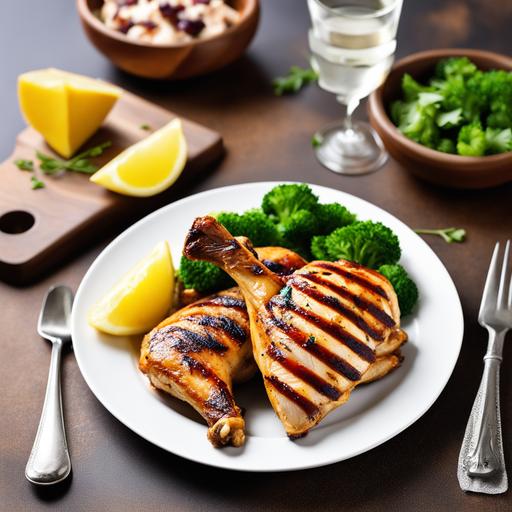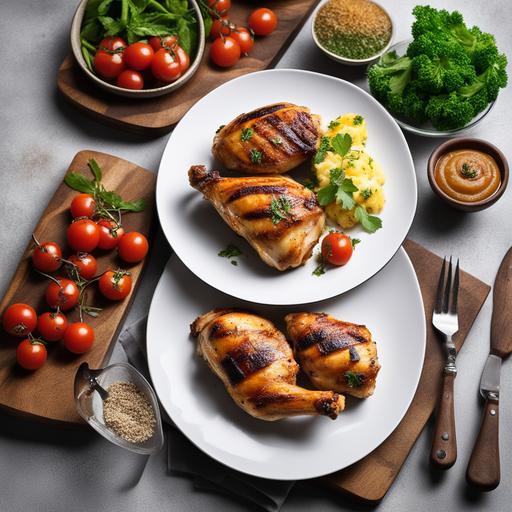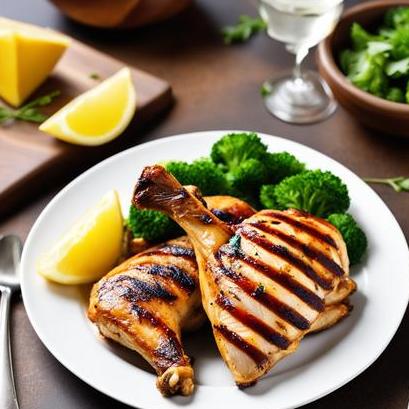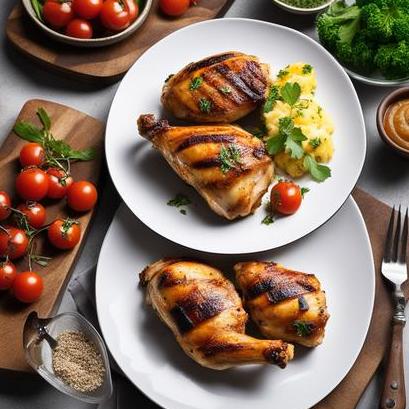
Grilled Chicken Oven Recipe: A Mouthwatering Delight
Grilled chicken is a versatile dish loved by many for its juicy, flavorful taste and its ability to be customized with various marinades and seasonings. While grilling outdoors is a popular method, not everyone has access to a grill or favorable weather conditions. Fortunately, you can achieve equally delicious results using an oven. In this comprehensive guide, we’ll explore the art and science of cooking grilled chicken in an oven, from selecting the best ingredients to mastering the optimal cooking temperature and timing.
Grilled chicken is a staple in many cuisines around the world, prized for its simplicity and ability to be paired with a wide range of sides and sauces. Whether you’re hosting a summer barbecue or preparing a cozy family dinner, grilled chicken is a crowd-pleaser that never fails to satisfy.
While traditional grilling involves cooking over an open flame outdoors, not everyone has access to a grill or the opportunity to grill outdoors year-round. However, with the right techniques, you can achieve similar results using your oven, making it a convenient alternative for those times when grilling outdoors isn’t possible.
In this article, we’ll delve into the food science behind cooking grilled chicken in an oven, including the role of ingredients, preparation methods, and cooking temperature. We’ll also provide a step-by-step grilled chicken oven recipe that you can easily follow to create delicious, tender chicken with a perfectly grilled exterior.
Food Science Of Cooking Grilled Chicken In An Oven
Cooking grilled chicken in an oven involves a combination of techniques to achieve the desired texture, flavor, and appearance. Understanding the food science behind the process can help you optimize your cooking methods and produce consistently delicious results.
Maillard Reaction
One of the key aspects of grilling chicken is the Maillard reaction, a chemical reaction that occurs between amino acids and reducing sugars when exposed to heat. This reaction is responsible for the browning and development of complex flavors and aromas in grilled foods.
In an oven, the Maillard reaction occurs when the surface of the chicken is exposed to high heat, resulting in the formation of a flavorful crust. To enhance the Maillard reaction, it’s important to ensure that the chicken is properly seasoned and that the oven is preheated to the appropriate temperature.
Moisture Retention
One challenge when cooking chicken in an oven is retaining moisture to prevent dryness. Unlike grilling over an open flame, which can quickly sear the exterior while keeping the interior juicy, an oven-cooked chicken requires more attention to moisture retention.
To retain moisture, it’s essential to choose the right cuts of chicken, such as bone-in, skin-on pieces, which naturally contain more moisture and fat. Additionally, marinating the chicken before cooking can help infuse it with flavor and moisture, while basting during cooking can further prevent dryness.
Temperature Control
Temperature control is crucial when cooking grilled chicken in an oven to ensure that it cooks evenly and reaches a safe internal temperature. The recommended internal temperature for cooked chicken is 165°F (74°C), which kills any harmful bacteria without overcooking the meat.
Preheating the oven to the correct temperature before cooking is essential for achieving optimal results. Additionally, using a meat thermometer to monitor the internal temperature of the chicken throughout the cooking process can help prevent overcooking or undercooking.
Choosing Ingredients
Selecting high-quality ingredients is the foundation of any delicious grilled chicken dish. From the type of chicken to the seasonings and marinades used, each component contributes to the final flavor and texture of the dish.
Chicken Selection
When choosing chicken for grilling in the oven, consider factors such as cut, quality, and freshness. Bone-in, skin-on chicken pieces, such as thighs, drumsticks, and breasts, are ideal for oven grilling as they tend to be more flavorful and moist than boneless, skinless cuts.
Look for chicken that is fresh and free from any signs of spoilage, such as an off odor or slimy texture. If possible, opt for organic or free-range chicken for the best flavor and quality.
Seasonings And Marinades
Seasonings and marinades play a crucial role in enhancing the flavor of grilled chicken. A simple marinade consisting of olive oil, lemon juice, garlic, and herbs such as rosemary, thyme, and oregano can add depth and complexity to the dish.
You can also experiment with different flavor profiles by incorporating ingredients such as soy sauce, honey, mustard, or chili flakes into your marinade. Be sure to season the chicken generously with salt and pepper before applying the marinade to ensure that the flavors penetrate the meat.
Preparing Ingredients

Properly preparing the ingredients is essential for achieving tender, flavorful grilled chicken. From trimming excess fat to marinating for optimal flavor, each step contributes to the overall success of the dish.
Trimming And Patting Dry
Before seasoning and marinating the chicken, it’s important to trim any excess fat or skin to prevent flare-ups in the oven and promote even cooking. Use a sharp knife to remove any visible fat or skin from the chicken pieces, taking care not to remove too much as this can result in dryness.
Once trimmed, pat the chicken dry with paper towels to remove any excess moisture, which can inhibit the Maillard reaction and prevent the skin from crisping up during cooking.
Marinating
Marinating the chicken before cooking is a simple yet effective way to infuse it with flavor and moisture. To marinate the chicken, place it in a shallow dish or resealable plastic bag and pour the marinade over it, ensuring that it is evenly coated.
Allow the chicken to marinate in the refrigerator for at least 30 minutes, or ideally overnight, to allow the flavors to fully penetrate the meat. Be sure to turn the chicken occasionally to ensure that it marinates evenly on all sides.
Optimal Oven Cooking Temperature & Timing
Achieving the perfect grilled chicken in the oven requires careful attention to temperature and timing. By following these guidelines, you can ensure that your chicken cooks evenly and reaches a safe internal temperature without drying out.
Preheating The Oven
Preheating the oven to the correct temperature is essential for achieving optimal results when grilling chicken. For most oven-grilled chicken recipes, a temperature of 400°F (200°C) is recommended, as this allows the chicken to cook quickly while developing a golden-brown crust.
To preheat the oven, set it to the desired temperature and allow it to heat up for at least 10-15 minutes before adding the chicken. This ensures that the oven is evenly heated throughout, promoting even cooking and browning.
Cooking Time
The cooking time for oven-grilled chicken will vary depending on the size and thickness of the chicken pieces, as well as the specific recipe being used. As a general guideline, bone-in, skin-on chicken pieces will take approximately 30-40 minutes to cook at 400°F (200°C), while boneless, skinless chicken breasts may cook more quickly, in about 20-25 minutes.
It’s important to monitor the chicken closely during cooking and adjust the cooking time as needed to prevent overcooking or undercooking. Use a meat thermometer to check the internal temperature of the chicken, ensuring that it reaches 165°F (74°C) before removing it from the oven.
Grilled Chicken Oven Recipe
Now that you understand the science and techniques behind cooking grilled chicken in the oven, let’s put it all into practice with a delicious grilled chicken oven recipe. This recipe features bone-in, skin-on chicken thighs marinated in a flavorful blend of herbs and spices, then oven-grilled to perfection.
Ingredients
- 4 bone-in, skin-on chicken thighs
- 2 tablespoons olive oil
- 2 cloves garlic, minced
- 1 teaspoon dried thyme
- 1 teaspoon dried rosemary
- 1 teaspoon dried oregano
- Salt and pepper to taste
- Lemon wedges for serving
Instructions
-
Preheat your oven to 400°F (200°C) and line a baking sheet with parchment paper or aluminum foil for easy cleanup.
-
In a small bowl, combine the olive oil, minced garlic, dried thyme, dried rosemary, dried oregano, salt, and pepper to create the marinade.
-
Trim any excess fat or skin from the chicken thighs and pat them dry with paper towels.
-
Place the chicken thighs in a shallow dish or resealable plastic bag and pour the marinade over them, ensuring that they are evenly coated. Marinate the chicken in the refrigerator for at least 30 minutes, or ideally overnight.
-
Once the chicken has finished marinating, remove it from the refrigerator and allow it to come to room temperature for about 15 minutes.
-
Arrange the chicken thighs on the prepared baking sheet, leaving space between each piece to ensure even cooking.
-
Place the baking sheet in the preheated oven and bake the chicken thighs for 30-40 minutes, or until they are golden brown and cooked through, with an internal temperature of 165°F (74°C).
-
Once cooked, remove the chicken thighs from the oven and allow them to rest for a few minutes before serving.
-
Serve the grilled chicken thighs hot, garnished with lemon wedges for squeezing over the top.
Grilled chicken cooked in the oven offers a convenient and flavorful alternative to traditional outdoor grilling. By understanding the food science behind the process and following proper techniques, you can achieve tender, juicy chicken with a perfectly grilled exterior every time. From selecting the best ingredients to mastering the optimal cooking temperature and timing, this comprehensive guide has equipped you with the knowledge and skills to create delicious grilled chicken in your own kitchen. Whether you're hosting a backyard barbecue or preparing a weeknight dinner, oven-grilled chicken is sure to be a hit with family and friends alike.
Doneness Checks

Cooking grilled chicken in the oven involves a few key steps to ensure that the chicken is cooked to perfection. The process typically begins with marinating the chicken to infuse it with flavor and moisture, followed by cooking it at a high temperature to achieve that characteristic grilled texture and taste.
Determining when your grilled chicken is done is crucial to avoid undercooking or overcooking. Here are some methods for checking the doneness of your chicken:
Visual Inspection
- Color: Grilled chicken should have a golden-brown color on the outside.
- Juices: When pierced with a fork or knife, the juices should run clear, indicating that the chicken is cooked through.
- Texture: The chicken should feel firm to the touch, with no signs of rawness.
Internal Temperature
Using a meat thermometer is the most accurate way to check the doneness of chicken. Insert the thermometer into the thickest part of the chicken, making sure not to touch bone. The internal temperature should reach 165°F (75°C) to ensure that it is fully cooked and safe to eat.
Undercooking
Undercooked chicken poses a health risk, as it may contain harmful bacteria such as salmonella. Signs of undercooked chicken include:
- Pink or raw-looking flesh
- Blood or pink juices running from the meat
- Soft or rubbery texture
If you suspect that your grilled chicken is undercooked, return it to the oven and continue cooking until it reaches the recommended internal temperature of 165°F (75°C).
Overcooking
Overcooked chicken can be dry and tough, lacking the juicy tenderness that makes grilled chicken so enjoyable. Common signs of overcooked chicken include:
- Dry, stringy texture
- Charred or burnt exterior
- Loss of moisture and flavor
To prevent overcooking, monitor the chicken closely during the cooking process and remove it from the oven as soon as it reaches the desired internal temperature of 165°F (75°C). Additionally, avoid cooking chicken at excessively high temperatures, as this can lead to uneven cooking and dryness.
Troubleshooting

Even with careful attention to detail, issues may arise when cooking grilled chicken in the oven. Here are some common problems and their solutions:
Dry Chicken
- Cause: Overcooking or using lean cuts of chicken.
- Solution: Marinate the chicken before cooking to add moisture, or baste it with sauce during cooking to keep it moist. Alternatively, consider using chicken thighs instead of breasts, as they contain more fat and are less likely to dry out.
Uneven Cooking
- Cause: Variations in oven temperature or uneven placement of chicken pieces.
- Solution: Rotate the chicken halfway through cooking to ensure even browning. If using multiple racks, switch their positions in the oven halfway through cooking to promote even heat distribution.
Burnt Exterior
- Cause: Cooking chicken at too high a temperature or for too long.
- Solution: Lower the oven temperature and reduce the cooking time. Cover the chicken with foil during cooking to prevent excessive browning. Alternatively, sear the chicken in a hot skillet before transferring it to the oven to reduce cooking time.
Recipe Variations
Grilled chicken is versatile and can be customized with various marinades, seasonings, and cooking methods. Here are some delicious variations to try:
Lemon Herb Grilled Chicken
- Marinate chicken breasts in a mixture of lemon juice, olive oil, garlic, and fresh herbs such as rosemary, thyme, and parsley. Grill in the oven until cooked through, then serve with a squeeze of fresh lemon juice.
Teriyaki Grilled Chicken
- Combine soy sauce, brown sugar, garlic, ginger, and sesame oil to make a flavorful teriyaki marinade. Marinate chicken thighs in the sauce, then grill in the oven until caramelized and tender. Serve with steamed rice and vegetables for a complete meal.
Spicy BBQ Grilled Chicken
- Rub chicken drumsticks with a mixture of BBQ seasoning, paprika, cayenne pepper, and brown sugar for a spicy kick. Grill in the oven until charred and crispy on the outside, then brush with your favorite BBQ sauce before serving.
Grilled chicken made in the oven offers a convenient and delicious alternative to traditional outdoor grilling. By following proper cooking techniques and using flavorful marinades, you can create tender and juicy chicken that is sure to impress your family and friends. Experiment with different seasonings and sauces to customize your grilled chicken to suit your taste preferences. With this comprehensive guide, you’ll be well-equipped to master the art of making grilled chicken in the oven and enjoy mouthwatering meals every time.
Flavour Enhancement Tips
Grilled chicken oven recipe offers a convenient alternative to traditional outdoor grilling, allowing you to enjoy the savory goodness of grilled chicken regardless of weather or location constraints. By utilizing the oven, you can achieve tender, juicy chicken with a hint of smokiness and delicious charred flavor.
While the oven may not replicate the exact experience of grilling over an open flame, it presents an opportunity to infuse chicken with a variety of flavors and achieve desirable texture through proper techniques. With the right ingredients and methods, you can create restaurant-quality grilled chicken in the comfort of your own kitchen.
Flavor is paramount when it comes to grilled chicken, and there are several ways to enhance its taste when using the oven. Here are some tips:
Marinades And Rubs
Marinating chicken before cooking is a great way to infuse it with flavor and ensure tenderness. Opt for marinades containing acidic ingredients like lemon juice, vinegar, or yogurt, as they help tenderize the meat and add depth of flavor. Alternatively, dry rubs made with a blend of herbs, spices, and aromatics can create a flavorful crust on the chicken.
Seasonings
Don’t underestimate the power of simple seasonings like salt, pepper, garlic powder, and paprika. These basic ingredients can enhance the natural flavors of the chicken and create a delicious crust when cooked.
Smoke Infusion
While the oven lacks the direct heat and smoke of a grill, you can still achieve a smoky flavor by adding smoked paprika, liquid smoke, or using wood chips in a smoker box or foil pouch. Place the wood chips directly on the oven rack or in a pan beneath the chicken to impart a subtle smokiness to the meat.
Sauce Glazing
Applying a glaze or sauce during the cooking process can add an extra layer of flavor and moisture to the chicken. Whether it’s a tangy barbecue sauce, a sweet teriyaki glaze, or a spicy buffalo sauce, brushing the chicken with your favorite sauce halfway through cooking will infuse it with irresistible flavor.
Texture Enhancement Tips

In addition to flavor, achieving the perfect texture is key to making grilled chicken that is juicy and tender. Here are some tips for enhancing the texture of oven-grilled chicken:
Brining
Brining involves soaking the chicken in a saltwater solution before cooking, which helps it retain moisture and prevents it from drying out during the cooking process. To brine chicken, simply dissolve salt and sugar in water, then submerge the chicken in the solution for several hours before cooking.
High Heat Sealing
To lock in moisture and create a flavorful crust, start by searing the chicken over high heat before transferring it to the oven. This initial sear caramelizes the exterior of the chicken, sealing in juices and enhancing its overall flavor and texture.
Basting
Basting involves periodically coating the chicken with its juices or a flavorful liquid during the cooking process. This helps keep the chicken moist and adds layers of flavor as the liquids caramelize on the surface of the meat.
Resting
Allowing the chicken to rest for a few minutes after cooking is crucial for ensuring juiciness. Resting allows the juices to redistribute throughout the meat, resulting in tender, succulent chicken.
Cooking At Different Temperatures
The temperature at which you cook your grilled chicken in the oven can have a significant impact on its texture and flavor. Here’s how to adjust the temperature for different results:
High Temperature (400°F – 450°F)
Cooking chicken at a high temperature results in a crispy exterior and juicy interior. This method is ideal for achieving a golden-brown crust and locking in moisture quickly. However, be cautious not to overcook the chicken, as it can dry out if left in the oven for too long.
Moderate Temperature (350°F – 375°F)
Cooking chicken at a moderate temperature allows for more even cooking and helps prevent the exterior from becoming overly charred before the interior is fully cooked. This method is suitable for larger pieces of chicken or when cooking multiple pieces at once.
Low Temperature (250°F – 325°F)
Cooking chicken at a low temperature is ideal for achieving a tender, fall-off-the-bone texture. This slow-cooking method allows the chicken to cook gently and evenly, resulting in moist and flavorful meat. Low temperature cooking is perfect for barbecue-style chicken or when using a marinade that requires longer cooking times.
Cooking Tips
Mastering the art of oven-grilled chicken requires attention to detail and proper technique. Here are some additional tips to ensure success:
Use A Meat Thermometer
To avoid undercooking or overcooking the chicken, use a meat thermometer to monitor its internal temperature. Chicken is safe to eat when it reaches an internal temperature of 165°F (75°C). Insert the thermometer into the thickest part of the chicken to ensure accurate readings.
Positioning In The Oven
For even cooking, place the chicken on a wire rack set over a baking sheet rather than directly on the baking sheet. Elevating the chicken allows hot air to circulate around it, resulting in crispy skin and juicy meat.
Flip Halfway Through Cooking
To ensure that both sides of the chicken cook evenly, flip it halfway through the cooking process. This helps achieve a uniform golden-brown color and prevents one side from becoming overly charred.
Use A Broiler For Charred Finish
If you prefer a charred exterior on your grilled chicken, finish it under the broiler for a few minutes after it’s done cooking. This quick blast of high heat caramelizes the surface of the chicken, imparting a delicious charred flavor.
Serving Suggestions
Grilled chicken is a versatile dish that pairs well with a variety of sides and accompaniments. Here are some serving suggestions to complement your oven-grilled chicken:
Side Dishes
Serve grilled chicken with classic side dishes like mashed potatoes, roasted vegetables, or a crisp green salad. Other options include rice pilaf, grilled corn on the cob, or baked beans for a barbecue-inspired meal.
Sauces And Condiments
Enhance the flavor of grilled chicken with a variety of sauces and condiments. Offer barbecue sauce, honey mustard, chimichurri, or tzatziki for dipping or drizzling over the chicken.
Garnishes
Add visual appeal and extra flavor to your grilled chicken by garnishing it with fresh herbs like parsley, cilantro, or basil. Sliced lemon or lime wedges can also be served on the side for a refreshing citrusy touch.
Conclusion
Grilled chicken oven recipe offers a convenient and delicious way to enjoy this beloved dish year-round. By following the flavor enhancement tips, texture enhancement tips, and cooking techniques outlined in this guide, you can achieve perfectly grilled chicken with juicy, tender meat and irresistible flavor. Experiment with different marinades, seasonings, and cooking temperatures to customize your grilled chicken to your liking, and don’t forget to pair it with delicious sides and accompaniments for a memorable meal every time. With these tips and techniques, you’ll be well on your way to mastering the art of oven-grilled chicken.
FAQS
What Temperature Should The Oven Be Set To For This Grilled Chicken Recipe?
Preheat the oven to 425°F to ensure that the chicken cooks evenly and achieves a crispy outer layer.
How Long Should The Chicken Be Cooked In The Oven?
The chicken should be cooked for approximately 25-30 minutes, or until the internal temperature reaches 165°F. It’s important to use a meat thermometer to ensure that the chicken is fully cooked.
Do I Need To Marinate The Chicken Before Grilling It In The Oven?
While marinating the chicken is not required for this recipe, it can enhance the flavor. If you choose to marinate the chicken, allow it to marinate for at least 30 minutes before placing it in the oven.
Can I Use Boneless, Skinless Chicken Breasts For This Recipe?
Yes, boneless, skinless chicken breasts can be used for this recipe. However, it’s important to adjust the cooking time accordingly, as they may cook faster than other cuts of chicken.
Should I Cover The Chicken With Foil While It’s Cooking In The Oven?
It’s not necessary to cover the chicken with foil while it’s cooking in the oven. Leaving it uncovered will help it develop a nice crispy exterior. If the chicken starts to brown too quickly, you can loosely tent it with foil.


